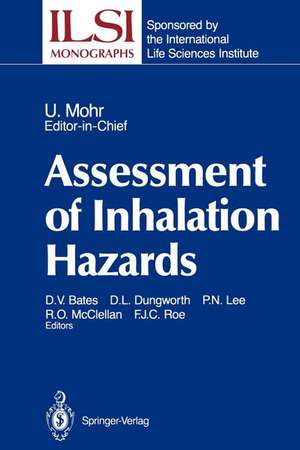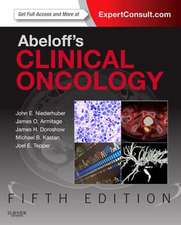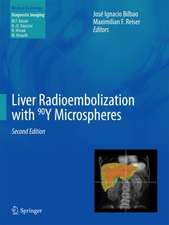Assessment of Inhalation Hazards: Integration and Extrapolation Using Diverse Data: Ilsi Monographs
David V. Bates Ulrich Mohr Donald L. Dungworth, Peter N. Lee, Roger O. McClellan, Francis J.C. Roeen Limba Engleză Paperback – 5 ian 2012
Preț: 721.40 lei
Preț vechi: 759.37 lei
-5% Nou
Puncte Express: 1082
Preț estimativ în valută:
138.04€ • 144.12$ • 114.25£
138.04€ • 144.12$ • 114.25£
Carte tipărită la comandă
Livrare economică 04-18 aprilie
Preluare comenzi: 021 569.72.76
Specificații
ISBN-13: 9783642746086
ISBN-10: 364274608X
Pagini: 400
Ilustrații: XVI, 382 p.
Dimensiuni: 155 x 235 x 21 mm
Greutate: 0.56 kg
Ediția:Softcover reprint of the original 1st ed. 1989
Editura: Springer Berlin, Heidelberg
Colecția Springer
Seria Ilsi Monographs
Locul publicării:Berlin, Heidelberg, Germany
ISBN-10: 364274608X
Pagini: 400
Ilustrații: XVI, 382 p.
Dimensiuni: 155 x 235 x 21 mm
Greutate: 0.56 kg
Ediția:Softcover reprint of the original 1st ed. 1989
Editura: Springer Berlin, Heidelberg
Colecția Springer
Seria Ilsi Monographs
Locul publicării:Berlin, Heidelberg, Germany
Public țintă
ResearchCuprins
I. Integrative Approach to Assessing Human Health Risk: Two Contemporary Problems.- 1. Integrating Diverse Data Sets to Assess the Risks of Airborne Pollutants.- 2. Risk Assessment for Radon Inhalation Based on Animal Exposure Data and Human Epidemiology.- II. Types of Evidence: General Strengths and Weaknesses.- Section 1. Epidemiological.- 3. Inhalation Hazards: The Interpretation of Epidemiologic Evidence.- 4. Problems in Interpreting Epidemiological Data.- Section 2. Animal.- 5. Rodent Carcinogenicity Studies: Their Value and Limitations.- 6. The Quality and Relevance of Data from Studies in Laboratory Rodents.- Section 3. Dosimetric.- 7. Identification of the Effective Dose of Inhaled Toxicants: General and Specific Problems.- 8. Molecular Dosimetry of Chemical Carcinogens: Implications for Epidemiology and Risk Assessment.- Section 4. Mechanistic.- 9. Pathobiological Effects of Fibers and Tobacco-Related Chemicals in Human Lung Cells in Vitro.- 10. A Mechanistic Approach to Assess the Inhalation Toxicity and Hazard of Methylisocyanate and Related Aliphatic Monoisocyanates.- III. Case Studies.- Section 1. Formaldehyde.- 11. Inhalation Toxicity and Carcinogenicity of Formaldehyde in Animals: Significance for Assessment of Human Health Risk.- 12. Formaldehyde: Evidence of the Carcinogenic Potential from Epidemiological Data.- 13. Covalent Binding of Formaldehyde to DNA: Characterization of Reaction Products and Quantitation Following Inhalation Exposure.- Section 2. Arsenic.- 14. Environmental and Occupational Exposure to Arsenic.- 15. Is Inhaled Arsenic Carcinogenic for Sites Other Than the Lung?.- Section 3. Butadiene.- 16. Toxicology and Carcinogenicity of 1,3-Butadiene.- 17. Species Differences in Pharmacokinetics, Metabolism, and DNA Binding of Inhaled 1,3-Butadiene.- 18. Epidemiologic Data Related to Health Effects of 1,3-Butadiene.- Section 4. Benzene.- 19. A Review of the Toxicokinetics of Benzene.- 20. Benzene Haematotoxicity and Leukaemia.- Section 5. Mineral Fibers.- 21. Man-Made Mineral Fiber Exposure: Assessment and a Note on Nonoccupational Exposure to Asbestos in Air.- 22. Carcinogenicity of Fibers in Experimental Animals—Data and Evaluation.- 23. The Health Effects of Man-Made Mineral Fibers.- Section 6. Environmental Tobacco Smoke.- 24. Environmental Tobacco Smoke: Adverse Effects on Respiratory Infection, Respiratory Symptoms, and Lung Function.- 25. Environmental Tobacco Smoke and Cancer.- 26. Risk Assessment for Inhomogeneous Subgroups.- Section 7. Automotive Exhaust Emissions and Polycyclic Aromatic Hydrocarbons.- 27. Epidemiologic Studies of Populations Exposed to Motor Vehicle Exhausts and Polycyclic Aromatic Hydrocarbons.- 28. Exhaust-Specific Carcinogenic Effects of Polycyclic Aromatic Hydrocarbons and Their Significance for the Estimation of the Exhaust Exposure-Related Lung Cancer Risk.- 29. Molecular Dosimetry of Inhaled Diesel Exhaust.- IV. Interfaces Between Scientific Judgement and Prudent Environmental Health Policy.- 30. Risk Assessment as an Instrument of Environmental Policy.- 31. The Perils of Prudence.- 32. Science, Ethics and Public Policy.- 33. Recent Progress and Problems in Setting and Applying Occupational Exposure Standards.- Some Reflections on the Symposium.




















